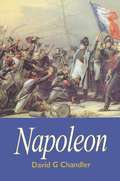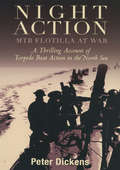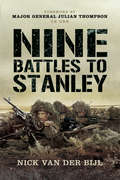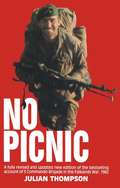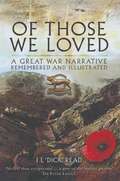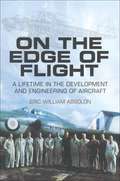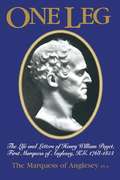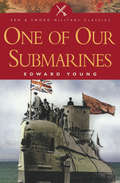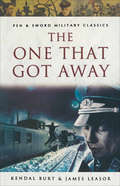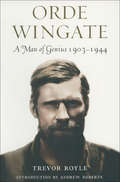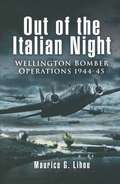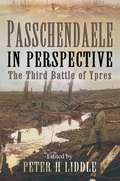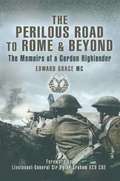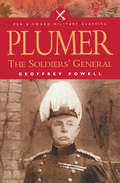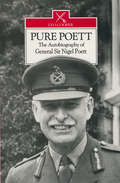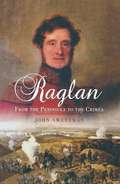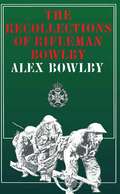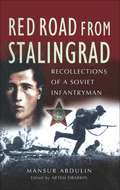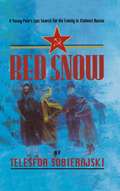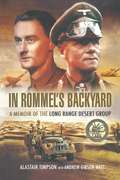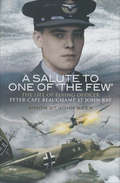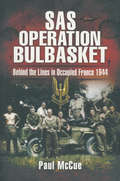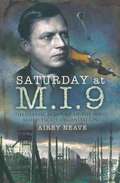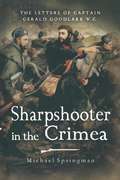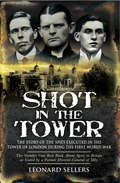- Table View
- List View
Napoleon: The Final Verdict (Praeger Illustrated Military History Ser. #20)
by David ChandlerThe acclaimed historian and author of The Campaigns of Napoleon presents his classic biography of the 19th century French Emperor and military leader. Born on the island of Corsica in 1769, Napoleon Bonaparte entered L&’Ecole Militaire in Paris at the age of fifteen. He supported the French Revolution and began to distinguish himself as a soldier at the Siege of Toulon. After a phenomenal rise to power through the military machine, Napoleon became the de facto ruler of France by the age of thirty. A widely celebrated historian of the Napoleonic Era, David Chandler chronicles the life of Napoleon Bonaparte, capturing one of history&’s greatest military minds in a lively and dramatic narrative. Chandler traces Napoleon&’s development as a military commander through the hard-fought battles at Marengo, Austerlitz, Jeana-Auerstadt, Friedland, the Peninsular War, the Russian campaign, and his final defeat at Waterloo.
Night Action: MTB Flotilla at War: A Thrilling Account of Torpedo Boat Action in the North Sea
by Peter DickensA highly decorated Royal Navy officer recounts his experiences at the command of a motor torpedo boat in the North Sea during WWII. In 1942-43, Captain Peter Dickens commanded the 21st MTB Flotilla, mainly in the North Sea and the English Channel. In Night Action, he vividly recounts his experiences performing daring missions amid storms of gunfire, usually under the cover of darkness. Dickens and his crew managed to closely engage enemy convoys and escorts in high-speed attacks and wreak havoc among the German supply lines. Like the sailors who fought Nazi U-boats in the battle of the Atlantic, Dickens and his comrades were experiencing a new kind of warfare and had to develop techniques and tactics as they went along; their kind of action called for great courage, spilt-second timing and complete understanding between captain and crew. For his bravery and heroism, Dickens was awarded The Distinguished Service Order, a Distinguished Service Cross, and The Most Excellent Order of the British Empire. In Night Action, he offers a frank depiction of live aboard the 21st MTB Flotilla, combining comradery and humor with the true horror of war
Nine Battles to Stanley
by Nicholas van der BijlNine Battles to Stanley is a soldiers account of the ground fighting on South Georgia and the Falklands.What makes this book unique is the fascinating and objective way the author describes the experiences, view points and comparative qualities of both sides to the conflict. Fresh light is shed on the whole campaign even the best known battles at Goose Green (where Col. H. Jones won his VC) and the night attack on Mount Tumbledown.
3 Commando Brigade in the Falklands: No Picnic (Cassell Military Paperbacks Ser.)
by Julian ThompsonMajor General Julian Thompson first wrote No Picnic when the momentous events of April - June 1982 were fresh in his mind. As Commander of 3 Commando Brigade, he was at the heart of the planning and conduct of the War. Under his direct command had been the Royal Marine Commandos and the two battalions of the Parachute Regiment who conducted the lion's share of the fighting.No-one therefore is better qualified to tell the extraordinary story of there-taking of the Falkland Islands from the Argentinians. The author, now a celebrated military historian, has revised his early book and added for this 25 Anniversary edition more of his own personal thoughts and impressions.It is all too easy to overlook just how perilous and risky a venture this expedition to the depths of the Southern Hemisphere was. Victory and defeat hung in the balance. Even those who feel they know about this most remarkable of wars will learn more from reading this classic account.
Of Those We Loved: A Narrative 1914–1919 Remembered and Illustrated
by I L ReadThe Author was among the first to respond to Kitcheners call for volunteers in 1914. He joined 8th Battalion, The Leicestershire Regiment at the outbreak of war as a Private and, within weeks, he and the Battalion were heading for Northern France with the British Expeditionary Force.In this superb memoir we see how the spirit of adventurous patriotism that carried him to war gradually turns to sober reflection as the fighting intensifies and he loses so many friends and comrades at the Battles of the Somme and the Marne.In 1917 he is commissioned into the Royal Sussex Regiment and makes a long, hazardous journey to Egypt to join his new battalion only to be recalled to take part in the Second Battle of the Marne, where his leadership and bravery win him the Croix de Guerre. Written with great modesty and insight, Dick Reads account contains a wealth of graphic descriptions of his experiences over the whole period of The Great War including the Somme 1916, Hindenburg Line, Egypt, Flanders and the Final Advance. The book is further enhanced by the inclusion of excellent drawings by the Author himself.Many memoirs will be published to commemorate the Centenary of the War to end all Wars but it can be said with confidence that Of Those We Loved is unlikely to be bettered. It makes for gripping reading both at home and as a companion onany visit to the Battlefields. Refined over the years, but retaining a rare sense of authenticity, this is a moving personal record of a survivors war and a profoundly moving epitaph for a lost generation.
On the Edge of Flight: A Lifetime in the Development and Engineering of Aircraft
by Eric William AbsolonThis is the story of Eric William Absolon, a relentlessly enthusiastic Aviation champion, whose lifelong love of aircraft has never wavered throughout his long and varied career. From boyhood fascination to the adult realization of his ambitions, this first-hand account takes in some of the key events of the dynamic period of twentieth century history which the author lived and worked through. Working his way up the ranks of the Gloster Aircraft Company, Absolon was able to see all the component processes of Aircraft production. The insight he provides into the inner workings of this busting center of Twentieth Century Aircraft production is unparalleled in modern accounts. Anyone with a fascination for the secret life of Aircraft is in for a treat here as the author relays his working experiences at the creative hub of the industry. His experiences including involvement with the post-war Drop testing of Meteor aircraft, working closely with these infamous vehicles of war in his role as Chief of Engineering Research, as well as an involvement with the more commercial side of Aviation production, a division within Gloster for which he served as Manager. This narrative charts his career with Gloster as well as a series of other companies who invited Absolon to offer his services. It also relays the story of the implementation and development of his own Aviation production business, Aljac Engineering Ltd. His expertise was highly prized then, and is now applied in the translation of experience into engaging prose, set to appeal to all genre enthusiasts.
One Leg: The Life and Letters of Henry Wiliiam Paget, First Marquess of Anglesey, K.G. 1768–1854
by The Marquess of AngleseyLetters and unpublished material contribute to this dramatic, humorous, and romantic biography of the heroic nobleman written by his descendant. Henry William Paget, first Marquess of Anglesey, was born more than twenty years before the French Revolution. Like his famous contemporary the Duke of Wellington, he became a legend during his lifetime. As a youth he was in one scrape after another; in his forties he figured in a celebrated elopement and duel which caused much scandal; but he is best known for his greatness as a cavalry leader. His brilliant timing of the charge of his &“heavies&” at Waterloo averted disaster in the first crisis of that battle. Having lost a leg by one of the last shots fired on that sanguinary day, he was later known as One-Leg Paget. Anglesey was twice lord-Lieutenant of Ireland. He was still in high office two years before his death at the age of sixty-five. Among the famous figures prominent in this absorbing story are the Prince Regent, Queen Victoria, Sir John Moore, Lord Melbourne, Daniel O&’Connell and, of course, the &“Iron Duke,&” with whom Anglesey was often at odds but of whom in old age he became a very close friend.
One of Our Submarines (Pen & Sword Military Classics)
by Edward Young&“[Young] immortalized his distinguished war service as a submariner in the bestselling autobiography, One of Our Submarines . . . [a] gripping memoir.&”—The Guardian &“In the very highest rank of books about the last war. Submarines are thrilling beasts, and Edward Young tells of four years&’ adventures in them in a good stout book with excitement on every page. He writes beautifully, economically and with humor, and in the actions he commands he manages to put the reader at the voice-pipe and the periscope so that sometimes the tension is so great that one has to put the book down.&”—The Sunday Times &“No disrespect to the big screen, but you can&’t beat a book for digging out the details. And the details feel even better if the author is someone who&’s been there. So, at least take the time to read Das Boot, the autobiographical novel by Lothar-Günther Buchheim. And, for the British perspective, read One of Our Submarines by Edward Young.&”—The Mouldy Books &“He tells his story in a modest, clear, and amusing way that is a delight to read.&”—not too much
The One That Got Away (Pen & Sword Military Classics)
by Kendal Burt James LeasorIn World War II James Leasor was commissioned into the Royal Berkshire Regiment and posted to the 1st Lincolns in Burma and India, where he served for three and a half years. His experiences inspired him to write such books as Boarding Party (filmed as The Sea Wolves). He later became a feature writer and foreign correspondent at the Daily Express. Here he wrote The One that Got Away. As well as non-fiction, Leasor has written novels, including Passport to Oblivion, filmed as Where the Spies Are with David Niven
Orde Wingate: A Man of Genius, 1903–1944 (Phoenix Giants Ser.)
by Trevor Royle&“A superb biography&” of the controversial British Army officer who lead the 77th Indian Infantry Brigade against the Japanese in Burma during World War II (HistoryOfWar.org). Winston Churchill described Wingate as a man of genius who might well have become a man of destiny. Tragically, he died in a jungle aircraft crash in 1944. Like his famous kinsman Lawrence of Arabia, Wingate was renowned for being an unorthodox soldier, inclined to reject received patterns of military thought. He was a fundamentalist Christian with a biblical certainty in himself and his mission. He is best-remembered as the charismatic and abrasive leader of the Chindits. With the support of Archibald Wavell, he was responsible for a strategy of using independent groups deep behind enemy lines, supported only by air drops. Wingate was responsible for leading the charge of 2,000 Ethiopians and the Sudan Defence Force into Italian-occupied Abyssinia. Remarkably, he defeated a 40,000 strong enemy that was supported by aircraft and artillery, which Wingate did not possess. Despite his achievements, Wingate suffered from illness and depression and in Cairo attempted suicide. He was not universally liked: his romantic Zionism contrasted with the traditional British Arabist notions. He did, however, lead from the front and marched, ate and slept with his men. In this authoritative biography, Royle expertly brings to life a ruthless, complex, arrogant but ultimately admirable general.&“An insightful look at the controversies which have dogged Wingate&’s reputation over the years . . . strongly recommended to anyone interested in irregular warfare and counterinsurgency operations.&” —African Armed Forces Journal
Out of the Italian Night: Wellington Bomber Operations, 1944–45 (Classics Ser.)
by Maurice G. LihouDuring 1944 and 1945 the squadrons of 205 Group were launching air attacks from bases in Italy. In many ways their efforts were the same as those of aircrew attached to Bomber Command in Britain, yet conditions for the men were very different. The men fought their war as much against the weather, as against the enemy. The Wimpy, as the Wellington was affectionately known, had been operational when war was declared and five years on their young crews were still taking them into battle. Maurice Lihou joined the RAF in 1939, just before the outbreak of war. He trained as a wireless operator to become aircrew, but found himself working in ground stations. He decided to re-muster as a pilot and completed his training in Canada where he was awarded his wings. He soon became captain of an aircraft and ferried a Wellington to North Africa. He was then posted to Italy and joined No 37 Squadron, becoming involved in various operations to harass the retreating German army.
Passchendaele in Perspective: The Third Battle of Ypres
by Peter H. LiddlePasschendaele In Perspective explores the context and real nature of the participants experience, evaluates British and German High Command, the aerial and maritime dimensions of the battle, the politicians and manpower debates on the home front and it looks at the tactics employed, the weapons and equipment used, the experience of the British; German and indeed French soldiers. It looks thoroughly into the Commonwealth soldiers contribution and makes an unparalleled attempt to examine together in one volume specialist facets of the battle, the weather, field survey and cartography, discipline and morale, and the cultural and social legacy of the battle, in art, literature and commemoration. Each one of its thirty chapters presents a thought-provoking angle on the subject.They add up to an unique analysis of the battle from Commonwealth, American, German, French, Belgian and United Kingdom historians. This book will undoubtedly become a valued work of reference for all those with an interest in World War One.
The Perilous Road to Rome and beyond: Fighting Through North Africa And Italy
by Edward GraceThe author fought with the 6th Battalion of the Gordon Highlanders during the campaigns of 1st Army in Tunisia and in Italy thereafter. As a young platoon commander he and his men were in the thick of the fighting. Wounded during the desperate action at Anzio, he wrote notes of all that had happened in exact detail and the result is a memoir both fresh and authentic. This is one of the most gripping memoirs we have published, on a par with Geoffrey Powell's Men At Arnhem The author also describes the actions of other regiments, particularly the Guards Brigade at Anzio, and US units, alongside whom he fought. In the closing stages of the book he shares his post-conflict experiences and convalescence with the reader in a moving way.
Plumer: The Soldiers' General (Pen & Sword Military Classics)
by Geoffrey PowellSir Herbert Plumer stood out as an archetypal Colonel Blimp - smart to a fault, white hair, white moustache, pot-belly. But his appearance belies the fact that he was one of the best-performing and best-regarded officers on the Allied side. Plumer's crowning glories were the attack on Messines Ridge in 1917 and his successful implementation of the 'bite and hold' strategy that contributed so much to final victory. Plumer destroyed all his papers, but the author has meticulously researched this biography, and has written a lucid account of this undeservedly neglected hero which throws fresh light on generalship on the Western Front.
Pure Poett: The Autobiography of General Sir Nigel Poett
by Nigel PoettThis is the story of a professional soldier and of his many adventures throughout the world. His father was a soldier, and it was no surprise when young Nigel Poett went to Sandhurst and then to Egypt, the North-West Frontier, India, Japan, Australia and New Zealand. His long career included appointment as Director of Military Operations in the Suez crisis and Commandant-General of Staff College, and ended with his command of the Far East Land Forces. Possibly the most eventful period, however, was when, as an Airborne Brigadier, he was given the task of commanding the airborne assault on the two vital bridges over the Orne which had to be captured to secure the left flank of the Normandy Invasion front.
Raglan: From the Peninsula to the Crimea
by John SweetmanAll too many historians have dismissed FitzRoy James Henry Somerset, first Baron Raglan, as at best, an indifferent and, at worst, an incompetent on the basis of his association with the infamous Charge of the Light Brigade.Yet as this long overdue biography of a pivotal military figure of the 19th Century reveals Raglans achievements over fifty years should not be judged on so narrow a basis. True, as Commander of the Expeditionary Force to the Crimea, he must take his share of responsibility for the hardship suffered by the men under him particularly during the winter of 1854-55 but the fact remains that Raglan never lost a battle for which he was fully responsible.Commissioned in 1804 he served under Sir Arthur Paget and the Duke of Wellington, throughout the Peninsular War losing an arm at Waterloo. He held key posts, including Military Secretary for an astonishing 25 years and Master General of the Ordnance and his influence was far reaching.Raglan is revealed in this objective study as a brave, thoughtful, caring and capable man, who found himself an easy target for critics of an outdated and inadequate military administrative system. Very personal attacks, some from official quarters, mortally wounded him and he died in June 1855, a mere seven months after being appointed a field marshal amid public acclaim.In this first full biography of Raglan, John Sweetman examines not just the man himself but the workings of an Army that was straggling to keep up with social and technological change. Readers will find this a fine expos of a man who was placed in a no-win situation through little fault of his own.John Sweetman graduated from Brasenose College Oxford (Modern History) before taking a PhD at Kings College, London. He later became Head of Defence and International Affairs at RMA Sandhurst. He is the author of numerous military works. Now retired he lives at Camberley.
The Recollections of Rifleman Bowlby (Cassell Military Paperbacks Ser.)
by Alex BowlbyThe classic memoir by an infantryman in the British army during the Second World War, &“a book to bring a shiver to the most grizzled veteran (The Sunday Times). In 1944, having distinguished itself in the North Africa campaign, Rifleman Bowlby&’s battalion of Greenjackets was sent to Italy. But instead of being used in the specialized role for which it had been trained, most of the battalion&’s vehicles were taken away on arrival, and the riflemen were told that they were to be used as ordinary infantry. Stripped of its hard core of regulars, the battalion suffered one disastrous defeat after another until its hard-won reputation fell in tatters. This is a memoir that captures &“quite extraordinary realism in this worm&’s eye view . . . the sweating, slogging, frightened infantryman in conditions of extreme stress and horror&” (The Sunday Times).
Red Road from Stalingrad: Recollections of a Soviet Infantryman
by Mansur AbdulinA Soviet infantryman offers a raw and candid look at life and death on the Eastern Front of WWII in this harrowing military memoir. While the average Soviet infantryman survived the battlefield for mere weeks before being killed or wounded, Mansur Abdulin fought on the front ranks for an entire year—and survived to tell his remarkable story. His extensive service pitted him against the German invaders at Stalingrad, Kursk and on the banks of the Dnieper. He therefore saw and engaged in some of the most bitter fighting in all of World War II. Abdulin&’s vivid inside view of the ruthless war on the Eastern Front gives a rare insight into the reality of the fighting as well as the tactics and mentality of the Soviet army. In his own words and with a remarkable clarity, Abdulin describes what combat was like on the ground, face to face with a skilled, deadly and increasingly desperate enemy.
Red Snow: A Young Pole's Epic Search for His Family in Stalinist Russia
by Telesfor SobierajskiThis is a unique personal story of the horrors of Stalin''s invasion of Poland, through the eyes of 14 year old Telesfor Sobierajski. He tells of his epic journey the rough Siberia in search of his family and their flight from Stalinist Russia.
In Rommel's Backyard: A memoir of the Long Range Desert Group
by Alistair Timpson Andrew Gibson-WattThis WWII journal takes readers inside an elite reconnaissance and raiding unit operating behind enemy lines in the North African campaign. As a young man entering the maelstrom of World War II, Alastair Timpson had the good fortune to find his way into the most romantic of special force units, the Long Range Desert Group. In Rommel&’s Backyard describes the various roles of the LRDG, all of which involved great daring and endurance deep behind enemy lines. They were the eyes and ears of the Eighth Army, reporting enemy movement; they destroyed enemy aircraft, supply dumps, and vehicles; and they transported other special forces and agents to their objectives. Timpson kept a meticulous record of all his activities with the LRDG. Only after his death, did his son realize the significance of his father&’s journals. In Rommel&’s Backyard is a personal account of the LRDG that epitomizes the spirit of the entire campaign.
A Salute to One of 'The Few': The Life of Flying Officer Peter Cape Beauchamp St John RAF
by Simon St. John BeerA poignant biography of a pilot who made the ultimate sacrifice in World War II. In a quiet churchyard is the grave of an airman who lost his life fighting in the skies over southern England in October 1940. The author happened to come across this grave, and after some initial inquiries discovered that nobody in the town was aware that this Battle of Britain pilot lay at rest in their parish. Determined to discover more about the short life of this hero, he undertook several years of research to craft this biography. Peter Cape Beauchamp St. John joined the RAF in November 1937 on a four-year short service commission at the age of twenty. In July 1938 he was posted to No. 87 Squadron, being equipped with the then-new Hawker Hurricane fighter. After war had been declared, the Squadron was posted to France in support of the British Expeditionary Force, becoming operational on September 10, 1939. In March 1940 he was transferred to 501 Squadron in Tangmere, and then again in April to 74 Squadron as an operational pilot at Hornchurch, equipped with Spitfires. It was from here that he fought his part in the Battle of Britain. For those who may have forgotten &“The Few,&” this stirring story tells of the all-too-short life of one of the 544 young men who gave everything to defend Great Britain from Nazi aggression.
SAS Operation Bulbasket
by Paul McCueThe story of Operation Bulbasket is one of such tension and drama that any resume which revealed its outcome would rob the reader of the vital element of suspense. Suffice it to say that on 6 June, 1944, known to history as D-Day, two members of the SAS were dropped by parachute deep behind the lines in enemy-occupied France. Shortly to be Followed by others, amounting in all to fifty-five men, their task was to disrupt in every way possible the movement of German troops to the north to repel the Allied invasion of Normandy.Only now, with the release of hitherto classified documents and thanks to a remarkable amount of painstaking research on Paul McCue's part, can the full story of Operation Bulbasket be told. The author has traced the surviving main participants and, by their various but often contradictory accounts and much careful detective work, has managed to piece together what really happened in those dramatic eight weeks after 6 June. Indeed, thanks to this book, those survivors have only learned the full story which was hidden from them for over fifty years. This has to be one of the most remarkable stories ever to be written about the Second World War.
Saturday at M.I.9: The Classic Account of the WW2 Allied Escape Organisation
by Airey NeaveThe author of Flames of Calais details life in the top-secret department of Britain&’s War Office during World War II in this military memoir. Airey Neave, who in the last two years of the war was the chief organizer at M.I.9, gives his inside story of the underground escape lines in occupied North-West Europe, which returned over 4,000 Allied servicemen to Britain during the Second World War. He describes how the escape lines began in the first dark days of German occupation and how, until the end of the war, thousands of ordinary men and women made their own contribution to the Allied victory by hiding and feeding men and guiding them to safety. Neave was the first British POW to make a &“home run&” from Colditz Castle. On his return, he joined M.I.9 adopting the code name &“Saturday.&” He also served with the Nuremburg War Crimes Tribunal. Tragically Airey Neave&’s life was cut short by the IRA who assassinated him in 1979 when he was one of Margaret Thatcher&’s closest political allies.Praise for Saturday at M.I.9&“There isn&’t a page in the book which isn&’t exciting in incident, wise in judgment, and absorbing through its human involvement.&” —The Times Literary Supplement (UK)
Sharpshooter in the Crimea: The Letters of the Captain Gerald Goodlake VC, 1854–56
by Michael SpringmanThe letters home to his family by Gerald Goodlake, a young officer in the Coldstream Guards, make remarkable reading. They vividly describe the ill-preparedness of the British Army and the dire conditions experienced by all ranks in the Crimea. Goodlake's views on senior officers were frank to say the least! Most important, Goodlake's initiative and courage in organising and leading what were 'Special Forces' were rewarded by the award of one of the first Victoria Crosses. Goodlake served in the Crimea from early 1854 to the end two years later.
Shot in the Tower: The Stories of the Spies Executed in the Tower of London During the First World War
by Leonard SellersThe number 1 best book about spies in Britain. As listed by Dame Stelle Rimington Ex-Director-General of M.I.5.The first reaction to Leonard Sellers fascinating account of the spies who were executed in the Tower of London during the First World War is likely to be one of amazement at their ineptitude. Not one of them seems to have had any proper training or any idea of how to set about the job. This, of course raises the intriguing question: how many others were there who did know what they were up to and managed to escape detection? However, thanks to the more liberal attitude now prevalent regarding access to hitherto 'sensitive' material and to years of dogged research by Len Sellers, the remarkable, but somehow pathetic, stories of the eleven foreign agents who were caught and subsequently shot in the Tower for espionage can now be told. In these days when a mind-boggling array of equipment is available for the assimilation and transmission of supposedly secret information their antics strike one as little short of farcical, but for their efforts, inspired, it seems, more often by greed than patriotism, these men paid the ultimate price and paid it in the most historic site in Britain.Whether they deserved their fate, or indeed the niche in history which this book gives them, is for the reader to decide. What cannot be denied is that their collected histories make remarkable reading.
